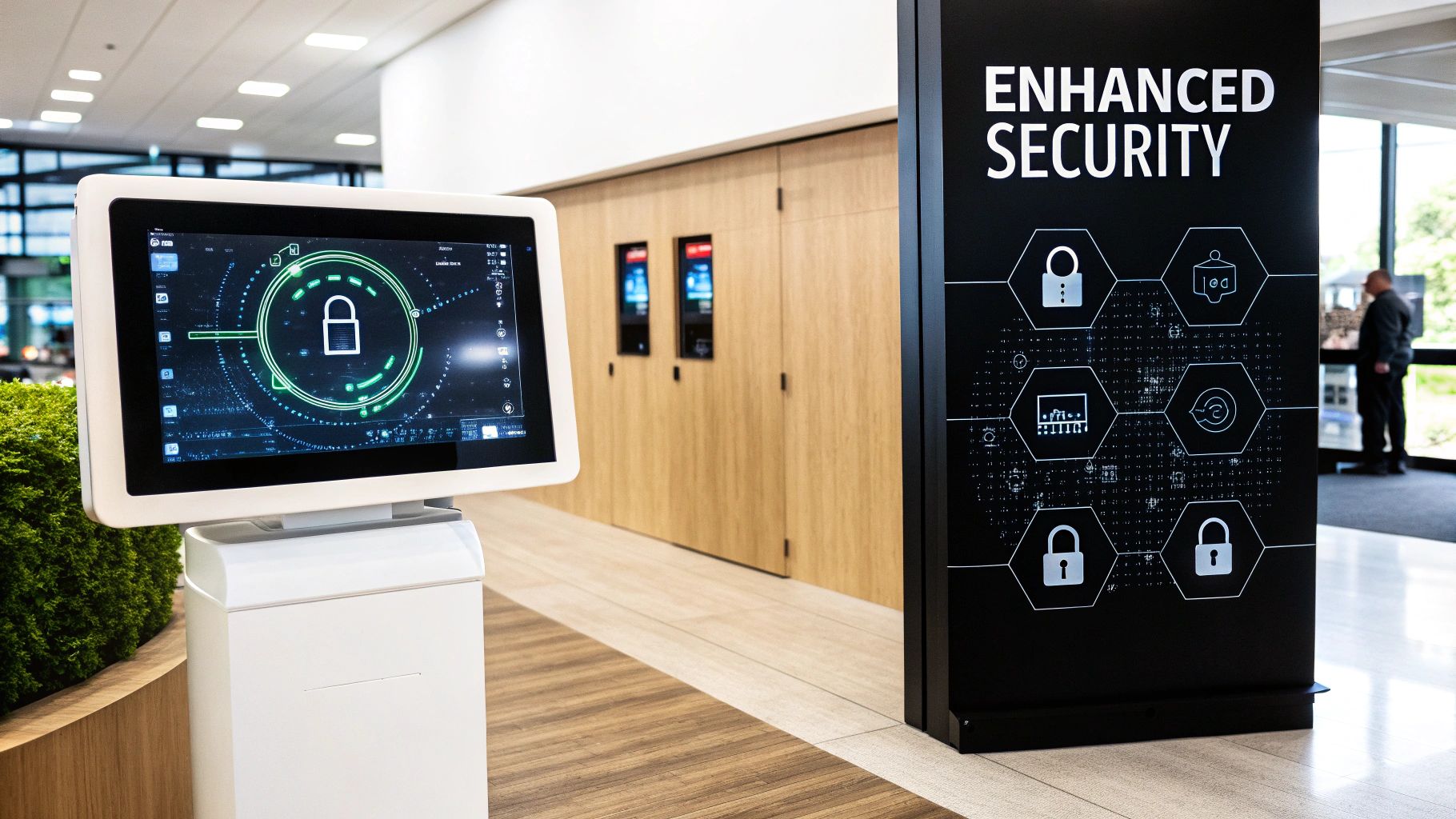
Shared Password Management: A Team Security Guide
Share
The Reality of Shared Password Management Today

In today's interconnected workplace, shared access to online accounts is a necessity for team collaboration and overall productivity. However, the current methods of shared password management often create significant security risks. Many organizations face the difficult task of balancing the need for easy access with the crucial responsibility of protecting sensitive data.
This gap between ideal security practices and the everyday reality of password sharing leaves organizations vulnerable to serious consequences.
Common Password Sharing Challenges
One major challenge is the widespread use of insecure sharing methods. Teams frequently share passwords through shared spreadsheets, email, or even chat applications like Slack. These methods offer very little security, making credentials easily accessible to unauthorized individuals.
They also lack access control and audit trails, making it nearly impossible to track who has access to which accounts. This lack of oversight creates a potential breeding ground for security breaches.
Another significant issue is the reliance on memory for managing shared passwords. This approach often leads to password reuse and weak passwords, drastically increasing the risk of unauthorized access. If one weak, reused password is compromised, multiple accounts become vulnerable.
This highlights the urgent need for stronger, more secure shared password management solutions.
To illustrate the global disparities in password management, let's take a look at the following table:
Password Management Methods: Global Comparison This table shows how different regions compare in their password management approaches, highlighting the disparities in secure practices across the globe.
| Region | Memory Reliance (%) | Password Manager Use (%) | Password Reset Frequency (%) |
|---|---|---|---|
| Global Average | 55 | 34 | N/A |
| North America | 51 | 37 | N/A |
| Europe | 56 | 35 | N/A |
| Asia-Pacific | 60 | 31 | N/A |
As shown in the table, relying on memory is still the most common method for managing passwords globally. The adoption of password managers, though growing, still lags behind, leaving a significant security gap.
The Importance of Secure Password Management
Even security-conscious organizations sometimes fall short when it comes to shared password management. The pressure to maintain productivity can lead to shortcuts that compromise security. A lack of clear policies and procedures further exacerbates the problem.
This creates a situation where even well-intentioned employees may inadvertently put the organization at risk. The consequences of these security lapses can be severe, ranging from costly data breaches to significant reputational damage.
Organizations must prioritize secure shared password management practices to protect their valuable assets and maintain a strong security posture. Utilizing tools like password managers can drastically reduce the risks associated with shared accounts. According to a 2023 Bitwarden survey, while 55% of respondents rely on memory, only 25% are required to use a password manager at work, despite 64% believing their workplaces should provide them. This data underscores the need for increased adoption of secure password management solutions. You can find more detailed statistics from the Bitwarden survey here.
When Password Sharing Goes Wrong: Real-World Consequences

The need for smooth teamwork often leads to shared password management. But what happens when these shared credentials are mishandled? The consequences can be devastating. This section explores the real-world impact of poor shared password practices, looking at actual incidents and data breaches.
The Price of Insecure Practices
One of the biggest risks associated with insecure shared password management is credential stuffing attacks. These attacks take advantage of the widespread habit of password reuse.
Hackers obtain compromised login details from one platform and then try those same credentials on other websites. This is surprisingly effective, simply because many people use the same passwords for multiple accounts. When considering shared password management, exploring alternatives like shared mailboxes can be a helpful exercise.
Insider threats also pose a significant risk. A disgruntled employee or even a well-meaning but careless team member with access to shared passwords can cause serious damage, ranging from data theft to outright sabotage. Traditional methods of storing passwords, like shared spreadsheets or emailing them, dramatically increase the risk of these incidents.
Real-World Examples and Their Impact
Many organizations have learned the hard way about the serious repercussions of weak shared password practices. In 2020, a leading social media company suffered a major data breach after employees inadvertently shared passwords on an internal messaging platform. Millions of user accounts were exposed, leading to significant reputational damage for the company.
In another case, a major e-commerce retailer faced substantial financial losses after hackers gained access to shared administrative credentials. The hackers then used these credentials to steal customer data and make fraudulent purchases.
These examples show how even seemingly small slip-ups in shared password management can lead to catastrophic outcomes. They underscore the vital importance of adopting secure practices and using robust shared password management tools. Moving to a dedicated password management solution can significantly reduce these risks.
The Growing Need for Secure Solutions
The increasing frequency of data breaches and cyberattacks highlights the urgent need for robust shared password management. A study from Security.org revealed that while 36% of American adults used password managers as of December 2024, risky behaviors like password reuse (almost 20%) and insecure storage methods remain prevalent.
This points to a significant gap between security awareness and the actual adoption of best practices. However, the study also offered a glimmer of hope: over 75% of non-users expressed a willingness to use password managers if they met their needs. This growing awareness, combined with the rise in cyber threats, is fueling the demand for efficient and secure shared password management solutions.
Choosing The Right Shared Password Solution For Your Team

Not all shared password management solutions are the same. Finding the perfect fit for your team means carefully thinking about your specific needs and what you need for security. This section will help you choose a shared password solution that is both effective and secure. You might also be interested in: Our collection of blog posts.
Understanding The Different Types of Solutions
There are three main types of password management solutions: consumer, team, and enterprise. Consumer solutions are built for individual users. They usually offer basic password storage and generation. Team solutions, such as AccountShare, are all about secure sharing and collaboration. This makes them a good choice for small to medium-sized businesses. Enterprise solutions offer more advanced features. These include granular access control, detailed audit logs, and integration with existing IT systems.
Picking the right type depends on several factors. These include your team's size, how much you collaborate, and your security needs. A small team with basic sharing needs may find a team solution is enough. A larger enterprise working with highly sensitive data will likely need a more robust enterprise solution.
Key Features To Look For
When looking at shared password management solutions, certain features are essential:
- Strong Encryption: Choose solutions that use strong encryption methods like AES-256 to protect stored passwords. This keeps passwords safe even if the system is compromised.
- Two-Factor Authentication (2FA): 2FA provides another layer of security. It requires users to verify their identity using a second method, like a code sent to their phone.
- Role-Based Access Control: This feature allows admins to set different access levels for team members. This makes sure people only access the passwords they need.
- Password Sharing and Rotation Policies: Easy and secure password sharing is vital. The solution should also support automating password rotation. This lowers the risk of using compromised login details.
- Audit Logs: Audit logs provide a record of all access and changes to shared passwords. This allows organizations to track activity and spot potential security problems.
- Emergency Access: Think about what happens if someone important on your team is unavailable. A good solution will offer secure emergency access for specific people.
Comparing Solutions And Making The Right Choice
The best way to choose a solution is to compare different options side-by-side. Think about your specific needs. A good strategy is to create a table listing the features of each solution. Then you can see how well they fit your requirements. Also, think about things like how easy it is to use, if it works with your existing tools, and, of course, the cost.
To help you compare solutions, take a look at the table below:
Enterprise Shared Password Management Solutions Comparison: This table compares key features, pricing models, and security capabilities of leading enterprise shared password management solutions to help organizations make informed decisions.
| Solution | Core Features | Sharing Capabilities | Access Controls | Integration Options | Pricing Model | Best For |
|---|---|---|---|---|---|---|
| 1Password | Password storage, 2FA, password generator, Travel Mode | Secure sharing links, group sharing | Role-based access, granular permissions | Single sign-on (SSO), directory integration | Per user/month | Large enterprises |
| LastPass | Password storage, autofill, password health score, dark web monitoring | Folder sharing, delegated access | Group-based access | Limited integrations | Per user/month | Small to medium businesses |
| Dashlane | Password storage, VPN, dark web monitoring, identity theft protection | Secure sharing links, emergency contact | Customizable permissions | Single sign-on (SSO) | Per user/month | Individuals and families |
The table above highlights some of the key differences between popular enterprise password management solutions. By considering factors like core features, sharing capabilities, and integration options, businesses can choose the best solution for their needs.
By carefully comparing features and weighing the pros and cons, you can choose a shared password management solution that truly protects your team’s login information and simplifies how you work together.
Implementing Shared Password Management That Actually Works

Successfully implementing shared password management takes more than simply selecting the right software. It requires a strategic approach, one that considers both the technical side and the often-overlooked human element. This section offers a practical guide for effectively deploying shared password management within your organization.
Gaining Stakeholder Buy-In
Securing buy-in from all stakeholders is crucial from the outset. This includes not just management, but also the teams who will use the system every day. Clearly explain the advantages of shared password management, highlighting the improved security, reduced risk, and productivity gains. Be sure to address any workflow concerns and provide comprehensive training and support.
Structuring Role-Based Access Controls
Effective shared password management hinges on robust access controls. A role-based access control system is essential, granting permissions according to job function and responsibilities. This ensures team members can access only the passwords they absolutely need. This granular approach limits the damage from a single compromised account.
Creating User-Friendly Password Policies
Password policies must balance security with usability. While complexity is important, overly strict rules often encourage users to find workarounds, undermining the entire system. Encourage strong, unique passwords, and promote the use of passphrases. Passphrases are easier to remember while still offering good security. Password management solutions like AccountShare offer built-in features for generating and managing secure passwords, making it easier for users.
Phased Implementation and Training
A phased rollout makes for a smoother transition. Begin with a pilot group to test the chosen solution and identify any potential problems. Provide thorough training on how to use the password manager and enforce the new password policies.
For example, start by implementing shared password management within a single department. Gather feedback, and then make any needed adjustments before expanding to the rest of the organization. This step-by-step approach minimizes disruption and allows for continual improvement.
Establishing Clear Protocols
Develop clear protocols for password rotation, emergency access, and incident response. Regular password rotation is key for maintaining a strong security posture. AccountShare, for example, simplifies this with automated rotation features. Establish a clear process for granting emergency access to vital accounts, ensuring business continuity in unforeseen situations.
Finally, define a clear process for handling potential security incidents, such as suspected breaches or lost devices. This should include steps for reporting incidents, investigating compromises, and revoking access to affected accounts. This comprehensive approach to shared password management ensures your organization is prepared for anything.
The Evolving Landscape of Password Management Solutions
The world of shared password management is transforming. Driven by increasingly complex cybersecurity threats and the growing need for seamless workplace collaboration, understanding these changes is crucial for bolstering any organization's security.
The Rise of Enterprise-Grade Solutions
Organizations are becoming more aware of the risks associated with traditional password sharing. This has led to a surge in demand for robust, centralized solutions. Enterprise password management platforms offer advanced features:
- Granular access controls
- Detailed audit logs
- Integration with existing IT infrastructure
This shift signifies a growing understanding that shared password management demands a dedicated, security-focused strategy, moving beyond ad-hoc methods.
The rise of hybrid and remote work has further emphasized the need for secure, centralized password management. With geographically dispersed teams, accessing shared accounts requires both simplicity and security. AccountShare's product offerings might be of interest. Enterprise solutions offer the control and monitoring tools needed, regardless of employee location.
Market Growth and Regional Trends
The market for password management solutions is booming. In 2024, the global market was valued at approximately USD 2.74 billion. Projections indicate it will reach USD 9.01 billion by 2032, with a CAGR of 15.8%. Find more detailed statistics here. North America currently holds a 33.58% market share. However, the Asia Pacific region is poised for the fastest growth, driven by rapid digital advancement and a surge in small and medium-sized enterprises.
This growth highlights the increasing importance of shared password management against evolving cyber threats. Challenges remain, though. Limited awareness of best practices and technological hurdles still impede wider adoption. This underscores the importance of user education and readily implementable solutions.
Emerging Authentication Methods
Beyond traditional passwords, innovative authentication methods are emerging. Passwordless authentication, using biometrics and other factors, is gaining traction. This offers enhanced security and a streamlined user experience, reducing reliance on remembering and sharing complex passwords.
Zero-trust architectures are also gaining prominence in shared password management. Zero trust verifies every access attempt, regardless of user location or device. This bolsters security in distributed work environments.
The Future of Shared Passwords
The future of shared password management lies in merging robust enterprise solutions with cutting-edge authentication technologies. The objective is to build secure, seamless, and user-friendly systems for effective team collaboration without compromising security. As the digital world evolves, so will our methods for managing and protecting shared credentials. This necessitates continuous adaptation and a commitment to staying ahead of security best practices.
The Future of Shared Password Management
The world of shared passwords is constantly changing, thanks to new technology and the ever-present danger of cyberattacks. This exploration of emerging trends reveals how teams might handle shared access in the future.
Passwordless Authentication: A Glimpse into the Future
One of the biggest changes is the shift toward passwordless authentication. This method does away with traditional passwords, using instead biometrics (like fingerprint scanning and facial recognition), hardware tokens, and magic links emailed to users. Imagine accessing a shared social media account with a quick fingerprint scan rather than typing a complex password. This eliminates the risk of passwords being compromised.
This shift to passwordless systems makes access easier for team members and improves security, especially for organizations with remote teams where managing shared login information can be tricky.
Biometric Verification and Its Implications
Biometric verification, a core part of passwordless authentication, is becoming very popular. The growing presence of fingerprint scanners and facial recognition on our devices makes it easy to add them to shared access systems. While offering better security, this raises questions about privacy and data protection. Companies must think carefully about these issues when adding biometric solutions.
This development signifies a move toward safer and more convenient login information management, strengthening security and making access easier for teams.
The Rise of Zero-Trust Architectures
Zero-trust architectures represent another significant trend affecting shared password management. Zero trust is based on the idea of “never trust, always verify.” Every access attempt is fully authenticated, no matter the user's location or device. This is crucial in our current world of hybrid and remote work.
Picture a team member trying to access a shared marketing account. Even when working from home, their identity is verified, and the system requires a second factor of authentication, like a code sent to their phone. This significantly reduces the risk of unauthorized access.
The Role of AI and Machine Learning
AI and machine learning are increasingly used to enhance shared password management. These technologies can analyze access patterns and find anything unusual that might suggest suspicious activity. For example, if a user tries to log in from a new place or at a strange time, the system can flag it. This adds an extra security layer.
AI can also automate password rotation and enforce stronger password rules. This removes the burden from individual users and ensures consistent security. This all points to a future where shared password management is not just secure but also smart and proactive.
Regulatory Changes and Compliance
Finally, changing regulations are shaping the future of shared passwords. Stricter data privacy laws require organizations to rethink how they handle shared credentials. Staying ahead means adopting solutions with strong access controls, detailed audit trails, and robust encryption. This proactive approach is key to meeting future regulatory needs and maintaining strong security.
Building a Security-First Password Culture
Even with the best shared password management tools, true security relies on everyone in the organization actively participating. This section explores how to build a security-conscious culture, turning secure password practices into habits, not just rules.
Overcoming Resistance To Change
Implementing a new system often meets resistance. Some team members might be comfortable with current practices, while others may see security measures as extra work. To overcome this, clearly communicate the why behind the change. Explain how shared password management benefits everyone, protecting both individual and company data.
Highlighting the negative consequences of insecure practices, such as data breaches and reputational damage, can be a strong motivator. Additionally, involve team members in the process.
Asking for their input on implementation and addressing their concerns directly can significantly smooth the transition. For example, holding workshops or Q&A sessions can foster a sense of ownership and reduce anxiety.
Addressing Generational Differences
Different generations often have different approaches to security. While younger team members may be more accustomed to technology and online security risks, others might need more support and training. Tailor training programs to address these generational differences, ensuring everyone understands the importance of secure shared password management practices.
This means providing various learning formats, from hands-on workshops to online tutorials. You can also use relatable examples and scenarios that resonate with specific age groups, making the training more engaging and effective.
Making Security Second Nature
The goal is to integrate security into daily workflow, not disrupt it. Choose user-friendly shared password management tools like AccountShare that simplify password creation, sharing, and rotation. Provide ongoing support and resources, such as quick reference guides and troubleshooting assistance.
For instance, integrate the password manager with commonly used applications, making access seamless. Regularly remind team members of best practices through short, engaging communications. Making security convenient encourages adoption and reinforces good habits. You might be interested in: How to master sitemaps.
Measuring and Improving Compliance
Regularly assess how well security policies are being followed. Use the reporting and auditing features within your shared password management system to track password strength, access patterns, and compliance with rotation policies. This data can reveal areas for improvement and guide future training efforts.
Additionally, consider implementing a system for recognizing and rewarding good security practices. This could involve highlighting team members who consistently follow procedures or offering incentives for achieving high compliance rates. Positive reinforcement can motivate continued adherence to security protocols.
Real-World Success Stories
Many organizations have successfully implemented strong shared password management cultures. One company saw a significant decrease in security incidents after implementing a comprehensive training program and a user-friendly password manager. Another organization successfully transitioned to a passwordless authentication system, improving both security and user satisfaction.
These examples demonstrate that a security-first culture is achievable and beneficial. By prioritizing education, engagement, and user experience, organizations can foster a secure environment where everyone understands the importance of protecting shared credentials.
Ready to transform your team's security practices and streamline access to shared accounts? Discover how AccountShare can help you build a security-first password culture while boosting productivity. Visit AccountShare today to learn more and start your free trial.
